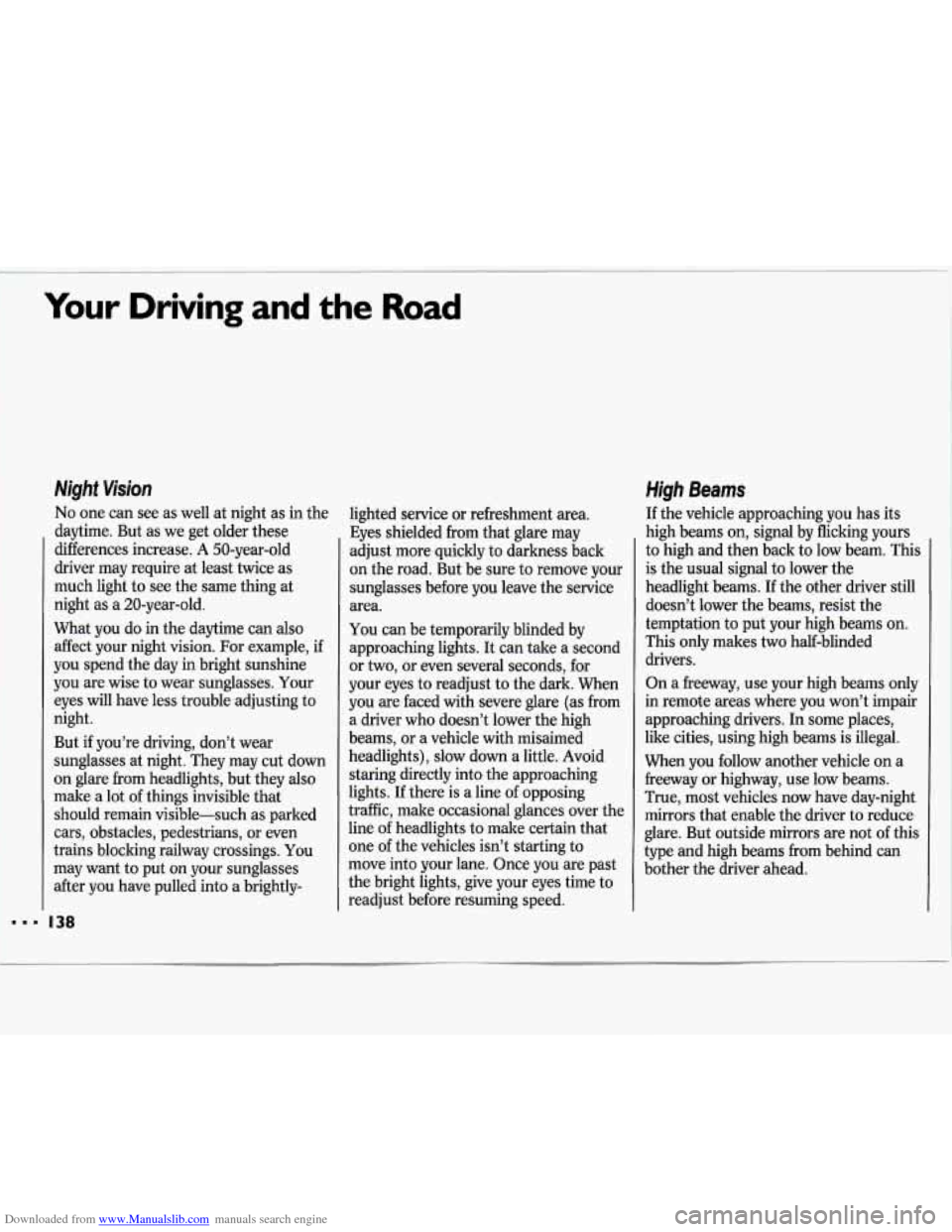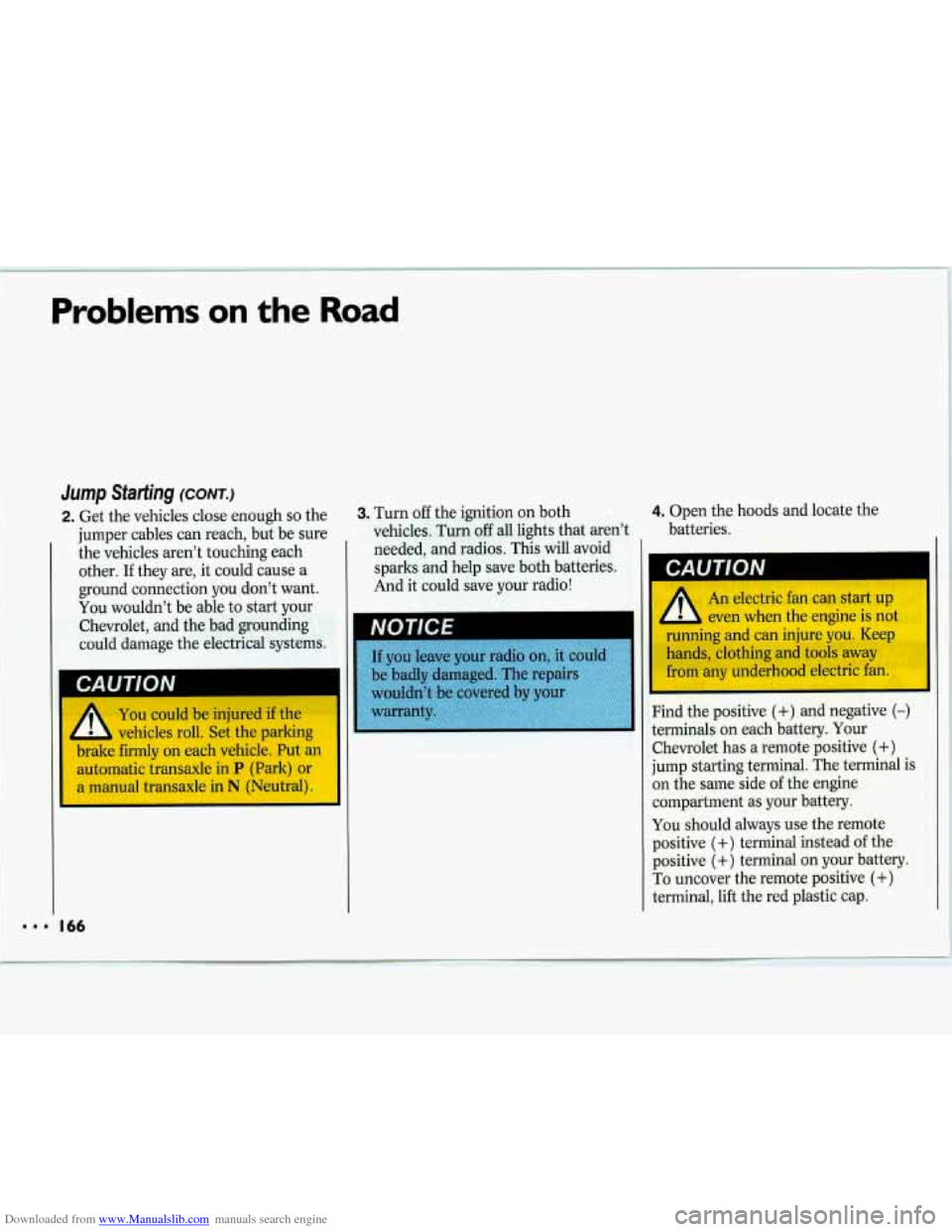Page 52 of 324
Downloaded from www.Manualslib.com manuals search engine Features & Controls
I 50
Remote Trunk Release (OPTION)
Press the yellow trunk release button
located under the instrument panel on
the driver’s side.
If you have an automatic transaxle, the
transaxle must be in
P (Park).
If you have a manual transaxle,
remember that your trunk can be
opened at any time using the lock
release. Be sure to lock your doors.
Convenience Net (OPTION)
Your vehicle may have a convenience
net. You’ll see it just inside the back
wall of the trunk.
Put small loads, like grocery bags,
behind the net. It can help keep them
from falling over during sharp turns or
quick starts and stops.
The net isn’t for larger, heavier loads. Store them in the trunk as far forward
as you can.
You can unhook the net
so it will lie flat
when you’re not using it.
Glove Box
I
To open, pinch the latch release. Use
the door lock key to lock and unlock the
glove box.
Page 140 of 324

Downloaded from www.Manualslib.com manuals search engine I
Your Driving and the Road
Night Vision
No one can see as well at night as in the
daytime. But as we get older these
differences increase.
A 50-year-old
driver may require at least twice as
much light to see the same thing at
night as a 20-year-old.
What you do in the daytime can also
affect your night vision. For example,
if
you spend the day in bright sunshine
you are wise to wear sunglasses. Your
eyes will have
less trouble adjusting to
night.
But
if you’re driving, don’t wear
sunglasses at night. They may cut down
on glare from headlights, but they also
make a lot
of things invisible that
should remain visible-such as parked
cars, obstacles, pedestrians, or even
trains blocking railway crossings.
You
may want to put on your sunglasses
after you have pulled into a brightly-
I38
lighted service or refreshment area.
Eyes shielded from that glare may
adjust more quickly to darkness back
on the road. But be sure to remove your
sunglasses before you leave the service
area.
You can be temporarily blinded by
approaching lights. It can tale a second
or two, or even several seconds, for
your eyes to readjust to the dark. When
you are faced with severe glare (as from
a driver who doesn’t lower the high
beams, or a vehicle with misaimed
headlights), slow down a little. Avoid
staring directly into the approaching
lights. If there is a line
of opposing
traffic, make occasional glances over the
line of headlights to make certain that
one of the vehicles isn’t starting to
move into your lane. Once you are past
the bright lights, give your eyes time to
readjust before resuming speed.
High Beams
If the vehicle approaching you has its
high beams on, signal by flicking yours
to high and then back to low beam. This
is the usual signal to lower the
headlight beams. If the other driver still
doesn’t lower the beams, resist the
temptation to put your high beams on.
This
only makes two half-blinded
drivers.
On a freeway, use your high beams only
in remote areas where you won’t impair
approaching drivers.
In some places,
like cities, using high beams is illegal.
When you follow another vehicle on a
freeway or highway, use low beams.
True, most vehicles now have day-night
mirrors that enable the driver to reduce
glare. But outside mirrors are not
of this
type and high beams from behind can
bother the driver ahead.
Page 168 of 324

Downloaded from www.Manualslib.com manuals search engine I
, “ >,
1 -. i,
Problems on the Road
Jump Starting (CONT.)
2. Get the vehicles close enough so the
jumper cables can reach, but be sure
the vehicles aren’t touching each
other.
If they are, it could cause a
ground connection you don’t want.
You wouldn’t be able to start your
Chevrolet, and the bad grounding
could damage the electrical systems.
You could be injured if the
vehicles roll. Set the parking
brake firmly
on each vehicle. Put an
automatic transaxle in
P (Park) or
3. Turn off the ignition on both
vehicles. Turn
off all lights that aren’t
needed, and radios. This will avoid
sparks and help save both batteries.
And it could save your radio!
If you leave your radio on, it
be badly damaged. The repairs
:,’
wouldn’t be covered by your
warranty.
4. Open the hoods and locate the
batteries.
r-
An electric fan can start up
- L even when the engine is not
running and can injure
you. Keep
hands, clothing and tools away
from any underhood electric fan.
Find the positive
(+) and negative (-)
terminals on each battery. Your
Chevrolet has a remote positive
(+)
jump starting terminal. The terminal is
on the same side of the engine
compartment as your battery.
You should always use the remote
positive
(+) terminal instead of the
positive
(+) terminal on your battery.
To uncover the remote positive
(+)
terminal, lift the red plastic cap.